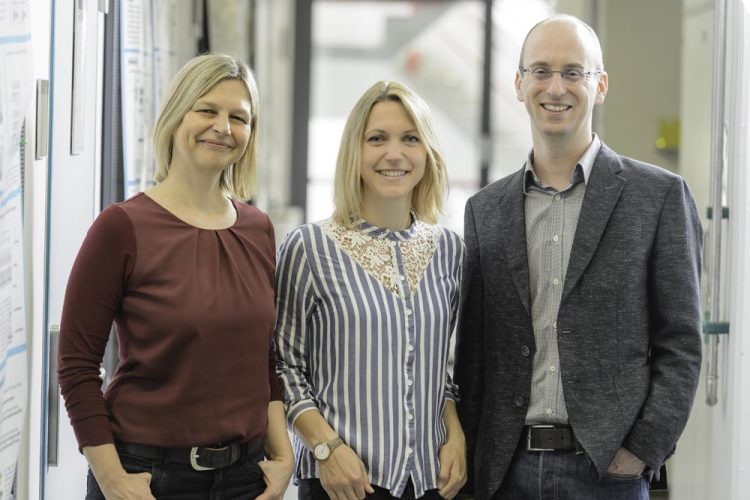Uncovering hidden protein structures

From left to right: Professor Karin Hauser, Annika Krüger und PD Dr Aswin Mangerich Copyright: Jespah Holthof, University of Konstanz
Using infrared (IR) spectrosocopy, researchers at the University of Konstanz were able to uncover the interaction between the p53 protein, a tumour suppressor that controls the cell cycle, and poly(ADP-ribose) (PAR) and deoxyribonucleic acid (DNA) at the molecular level.
The nucleic acid-like biopolymer PAR serves as a cellular signal transmitter and helps to regulate protein activity.
By studying the interaction between p53 and PAR, the researchers were able to learn more about molecular reactions to cellular stress in response to, for example, DNA damage, which represents a potential tumour risk.
Their basic research on the processes behind DNA damage is, on the one hand, paramount to understanding how cancer develops and how cells age.
On the other hand, the innovative scientific approach is advancing the research carried out in their field. Their research results were published in issue 9 (21 May 2019) of the scientific journal Nucleic Acids Research by the Oxford University Press.
In a new article published on “campus.kn”, the online magazine of the University of Konstanz, we tell the story of the project’s development, which builds on interdisciplinary linkages especially between early career researchers: https://www.campus.uni-konstanz.de/en/science/uncovering-hidden-protein-structur…
Key facts:
• Article on “campus.kn”, the online magazine of the University of Konstanz, about a novel spectroscopic approach to uncover protein structures that originates from interdisciplinary collaboration at the University of Konstanz
• Original publication: Annika Krüger, Anna Stier, Arthur Fischbach, Alexander Bürkle, Karin Hauser, Aswin Mangerich, Interactions of p53 with poly(ADP-ribose) and DNA induce distinct changes in protein structure as revealed by ATR-FTIR spectroscopy, Nucleic Acids Research, 2019, 47:9, 4843–4858 (https://doi.org/10.1093/nar/gkz175)
• Investigation of interaction between the p53 protein and poly(ADP-ribose) (PAR) and deoxyribonucleic acid (DNA)
• The basic research on the processes behind DNA damage is paramount to understanding how cancer develops and how cells age
Note to editors:
You can download a photo here:
https://cms.uni-konstanz.de/fileadmin/pi/fileserver/2019/Bilder/verborgene_prote…
Caption: From left to right: Professor Karin Hauser, Annika Krüger und PD Dr Aswin Mangerich
Copyright: Jespah Holthof, University of Konstanz
Contact
University of Konstanz
Communications and Marketing
Phone: + 49 7531 88-3603
E-Mail: kum@uni-konstanz.de
– uni.kn
Annika Krüger, Anna Stier, Arthur Fischbach, Alexander Bürkle, Karin Hauser, Aswin Mangerich, Interactions of p53 with poly(ADP-ribose) and DNA induce distinct changes in protein structure as revealed by ATR-FTIR spectroscopy, Nucleic Acids Research, 2019, 47:9, 4843–4858 (https://doi.org/10.1093/nar/gkz175)
Media Contact
More Information:
http://www.uni-konstanz.deAll latest news from the category: Life Sciences and Chemistry
Articles and reports from the Life Sciences and chemistry area deal with applied and basic research into modern biology, chemistry and human medicine.
Valuable information can be found on a range of life sciences fields including bacteriology, biochemistry, bionics, bioinformatics, biophysics, biotechnology, genetics, geobotany, human biology, marine biology, microbiology, molecular biology, cellular biology, zoology, bioinorganic chemistry, microchemistry and environmental chemistry.
Newest articles

Bringing bio-inspired robots to life
Nebraska researcher Eric Markvicka gets NSF CAREER Award to pursue manufacture of novel materials for soft robotics and stretchable electronics. Engineers are increasingly eager to develop robots that mimic the…

Bella moths use poison to attract mates
Scientists are closer to finding out how. Pyrrolizidine alkaloids are as bitter and toxic as they are hard to pronounce. They’re produced by several different types of plants and are…

AI tool creates ‘synthetic’ images of cells
…for enhanced microscopy analysis. Observing individual cells through microscopes can reveal a range of important cell biological phenomena that frequently play a role in human diseases, but the process of…





















